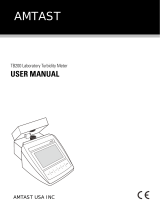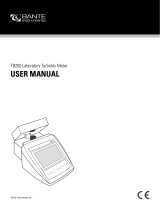Continuous Measurement
3.1 Ensure that the meter is in the continuous measurement mode.
3.2 Repeat steps 1.1 through 1.3 above.
3.3 Press the Meas key, the Measure icon begins flashing, the meter
continuously measures the sample.
To stop the measurement, press the Meas key again.
Data Management
Storing a Measurement Result
The TB100 turbidity meter is capable of storing and recalling up to
100 data sets. In the measurement process, press the MI key to store
the reading into the memory, the Memory icon appears on the display.
Viewing the Data Logs
1.1 Press the MR key, the meter shows the serial number of stored
data.
1.2 Press the key to view the date and time of measurement.
1.3 Press the key to view the stored data.
1.4 Press the key to view the next data set.
1.5 Press the Meas key to return to the measurement mode.
Clearing the Data Logs
If the memory is full, the meter will automatically show when
the MI key is pressed. To delete data logs, please follow the steps
below.
2.1 In the measurement mode, press and hold the key to enter
the setup menu.
2.2 Press the key until the meter shows / .
2.3 Press the Enter key, the meter shows / .
2.4 Press the key to select the / , press the Enter key
to confirm.
Communication
The meter can transfer the data to a computer or import the data to
Excel by a DAS software. You are able to download this software from
our official website. Before installation, make sure that the Windows
10 operating system has been installed on your computer.
Receiving the Data
1. Connect the USB cable to meter and computer.
2. Click the DAS_TB_Series icon, the system automatically scans
an available communication port and shows a message box
"Found a port on your computer".
3. Click the OK button, the application starts.
4. Click the Connect button, the screen shows "Port is connected".
5. Click the OK button, then click the Receive button, the stored
data automatically transfer to computer.
If your computer can not find a communication port, click the "CP210x
VCPInstaller_x64.exe or CP210xVCPInstaller_x86.exe" to update the
drive program.
Creating an Excel File
When the transfer is completed, click the Save as Excel button, the
readings in data sheet will automatically convert to Excel file.
Note, once the software is closed, all received data will be lost and
can not be recovered.














